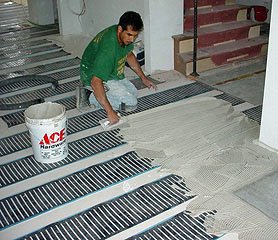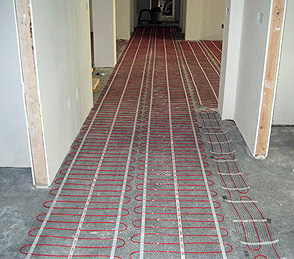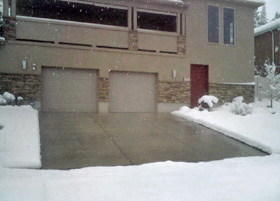Low Voltage and Line Voltage Radiant Heat Systems
There is some confusion in terms of low-voltage and line-voltage radiant heat systems. The aim of this article is to dispel some of the myths surrounding the different kinds of systems. Most reputable radiant heat providers offer both low-voltage and line voltage systems, and their representatives should go over the pros and cons of each system with you honestly and openly to help you during the decision process.
Low-voltage radiant heat systems actually use the same line voltage and consume the same amount of power as standard systems. The main difference is the use of a step-down transformer which reduces the current required to operate the system. Due to their safe low-voltage current (8-30v), low-voltage products like FloorHeat can be nailed and stapled down to secure the product to the floor and are therefore useful for installation under hardwood and carpet. The low-voltage product we recommend for interior radiant heating is FloorHeat. However, for snow melting applications, it is generally recommended to use line-voltage radiant heat systems. However, one of the most trusted and recommended roof de-icing solutions is the low-voltage RoofHeat STEP system, from Warmzone.
Myth 1: Low-voltage Radiant Heat Systems are Safer than Line-voltage Systems.
Low-voltage is low, so it makes sense that it’s safer, right? While this makes perfect sense initially, we have to take a closer look to find out the real answer. If your definition of safe is the chance of being hurt by voltage during installation, then yes, it is safer. Low-voltage will give you a bit of a shock, but won’t cause lasting damage. However, another question we should be asking is how durable is the heating element against damage and if it is cable, then how well is the cable insulated. Both line and low-voltage snow melting systems are embedded in concrete, asphalt, or under pavers. When installed properly the embedded systems are not exposed and not harmful. Some low-voltage heating wires are NOT designed to be embedded. These have only a thin layer of plastic and a heating element that is THHN/THWN wire. This wire is intended for interior use only, NOT for use in concrete, asphalt, or under pavers. Another thing to keep in mind is that low-voltage wires do not have ground fault protection, so electrical leakage can go undetected.
In contrast, line-voltage obviously has higher voltage, which is why line voltage cables are built to withstand wear and tear, and are much more difficult to damage - but you don't want to be shocked by line-voltage. If you happen to damage a line-voltage cable, don’t worry! Line-voltage systems are equipped with ground fault protection (GFEP) breakers with a 30 milliamp trip. Which means the system will automatically shut off when it has reached beyond allowable leakage levels. What does this mean? Well for one you don’t need to worry about bodily harm, but you also don’t need to worry about potential fire hazard from a damaged cable. The bottom line: both line-voltage and low-voltage systems are safe to use, with each offering its own advantages.
Myth 2: A Low-voltage Radiant Heat System Costs less to run than an Equally Sized Line-voltage system.
 It is true that low-voltage radiant systems won't deliver a nasty shock to installers,
but this doesn’t mean the systems are less costly to run. In worst case scenarios some
low-voltage systems may actually be more expensive to operate because these systems generally
produce less watts per square foot (such as 20 watts/sq. ft., which is below ASHRAE standards).
By producing less heat per square foot, it takes longer to heat the same area, thus increasing the time it takes to melt, and
thus, the cost. Because of the decreased heat output during heavier snowfalls, some low-voltage
systems may struggle to keep up with the snowfall, and have to remain on much longer.
For this reason, ASHRAE has set forth wattage standards for snow melting. But keep in mind, one of
the most effective roof heating systems is the low-voltage
RoofHeat STEP system.
While low-voltage systems are seldom used for driveway heating applications, they have proven to be
very capable for heating roofs, valleys and gutters.
It is true that low-voltage radiant systems won't deliver a nasty shock to installers,
but this doesn’t mean the systems are less costly to run. In worst case scenarios some
low-voltage systems may actually be more expensive to operate because these systems generally
produce less watts per square foot (such as 20 watts/sq. ft., which is below ASHRAE standards).
By producing less heat per square foot, it takes longer to heat the same area, thus increasing the time it takes to melt, and
thus, the cost. Because of the decreased heat output during heavier snowfalls, some low-voltage
systems may struggle to keep up with the snowfall, and have to remain on much longer.
For this reason, ASHRAE has set forth wattage standards for snow melting. But keep in mind, one of
the most effective roof heating systems is the low-voltage
RoofHeat STEP system.
While low-voltage systems are seldom used for driveway heating applications, they have proven to be
very capable for heating roofs, valleys and gutters.
Line-voltage snow melting systems are designed specifically for the environment in which they will be operating. These systems are made to produce the necessary watts (that meet ASHRAE standards) to melt snow as efficiently as possible.
Some low-voltage systems on the market have some distinct advantages over line voltage. FloorHeat is low voltage, but does not rely on heat cables to generate heat. FloorHeat is a self-regulating, semi-conductive polyethylene heating element that can be used for a wide variety of applications, and can be installed directly under carpet pad and hardwood. The heating element is even used for roof heating. Another advantage of the FloorHeat heating element is that you can hammer nails or staple through it without worry of damage! This feature is particularly beneficial when installing a roof heating system.
Myth 3: Low-voltage Radiant Heat Systems are Easier to Repair.
Both line-voltage and low-voltage cables are easy to repair. Simply remove the bad section of cable, add in a splice kit, cover it back over and the system should operate as normal. You do not have to replace the entire cable or rip out the entire surface, only the area that is damaged. The location of the break can be identified by using devices such as the DEVItrace or a TDR, which uses radio frequencies and a “wand” to locate the damaged section of cable. For more information on these devices, call (888.488.9276).
Myth 4: Low-voltage Systems are more Efficient.
 Line-voltage
and low-voltage radiant snowmelt systems are more efficient than hydronic snow melting
systems; however, low voltage is NOT more efficient than line voltage. Let's examine why
this is the case. Since low-voltage systems have a much lower output of heat per square
foot; they may take longer to melt snow. During heavy snowstorms the systems
may not be able to keep up with the demand. Further increasing to possible inefficiencies,
low-voltage systems must have the electricity pass through a transformer and
thick (2-gauge) power leads, which causes voltage to drop as it travels
distance before reaching the heating element. Line-voltage cables have the energy
to go directly into heating, without the loss of power.
Line-voltage
and low-voltage radiant snowmelt systems are more efficient than hydronic snow melting
systems; however, low voltage is NOT more efficient than line voltage. Let's examine why
this is the case. Since low-voltage systems have a much lower output of heat per square
foot; they may take longer to melt snow. During heavy snowstorms the systems
may not be able to keep up with the demand. Further increasing to possible inefficiencies,
low-voltage systems must have the electricity pass through a transformer and
thick (2-gauge) power leads, which causes voltage to drop as it travels
distance before reaching the heating element. Line-voltage cables have the energy
to go directly into heating, without the loss of power.
Myth 5: Low-voltage Systems Offer a Better Warranty.
Some low-voltage warranties are very deceiving. They boast of a 25-year warranty period, but when examined closer it is found that the 25-year warranty only covers the heating element. As discussed earlier these heating wires are actually THHN or THWN, which can be purchased relatively cheaply at any hardware store.
One of the best radiant heat cables is ClearZone line-voltage heat cable, and features a straightforward manufacturer warranty. (Remember, a warranty is only as good as the company that stands behind it, so as you research the various radiant heating options, we recommend dealing with established companies who pride themselves on customer service.)
Myth 6: Both Systems Provide Sufficient Heat.
Many low-voltage radiant heat systems in snow melting applications do not meet the ASHRAE standards. The minimum watts per square foot ASHRAE requires in North America is 32-watts. Popular low-voltage systems on average are designed to produce approximately 20-watts per square foot. Even with extremely tight cable spacing the system will max out at 30, which is still below the standards set forth by ASHRAE.
Line-voltage systems are designed specifically for the environment in which they will be operating. These systems are made to produce the necessary watts (that meet ASHRAE standards) to melt snow in the most efficient time possible. So as you are shopping for a radiant snow melting system, make sure the system is designed according to ASHRAE standards.
Myth 7: Both systems are UL Approved.
Most low-voltage snow melting systems are not UL listed. Make sure you install only radiant heat systems that are UL tested and approved. Again, this is another aspect the many homeowners overlook when shopping for the best radiant heating system.
SYSTEM WEAKNESSES
- THHN/THWN wire was not designed for concrete embedding. The outer jacket is soft and easily cut which will shorten its life.
- Low heat output – Does not satisfy ASHRAE requirements.
- Bulky and costly controls (transformer and control box are 100 lbs per 200-square-foot zone).
- Warranty – Only covers THHN/THWN wire. (Control box is 1 year, and the transformer is 5 years.)
- More Complex Installation – The transformer and control box can be complicated and time consuming to install.
- Noise – Many transformers emit noise, so location of where they are installed must be considered.
- Price – Because of the additional components, low-voltage systems are typically more complex to install and considerably more expensive than comparable line voltage systems.
 As radiant heating systems have gained popularity, a lot of fly-by-night manufacturers
tried to cash in on the recent boom. This sparked ASHRAE to come out with standards
for radiant snow melting systems to prevent abuse from manufacturers. Many low-voltage
radiant snow melting systems don't meet the ASHRAE standards for quality
and efficiency, so if you are looking for a low-voltage radiant heat system,
be sure that it meets ASHRAE standards. Unfortunately, not all consumers are
aware of standards in the radiant industry and unwittingly purchase faulty
products and end up with a negative experience working with radiant heat.
As radiant heating systems have gained popularity, a lot of fly-by-night manufacturers
tried to cash in on the recent boom. This sparked ASHRAE to come out with standards
for radiant snow melting systems to prevent abuse from manufacturers. Many low-voltage
radiant snow melting systems don't meet the ASHRAE standards for quality
and efficiency, so if you are looking for a low-voltage radiant heat system,
be sure that it meets ASHRAE standards. Unfortunately, not all consumers are
aware of standards in the radiant industry and unwittingly purchase faulty
products and end up with a negative experience working with radiant heat.
Rest assured there are plenty of efficient radiant heating systems that will run smoothly for decades without needing any maintenance. Deal only with reputable companies who offer several different types and brands of products. Also, make sure they also include complete radiant heat system design and installation support services with their systems. Thoroughly research products before making any purchases, which means checking for proper safety certifications and standards, so you can enjoy your radiant heating system for years to come.
BACK TO ARTICLES HOME
